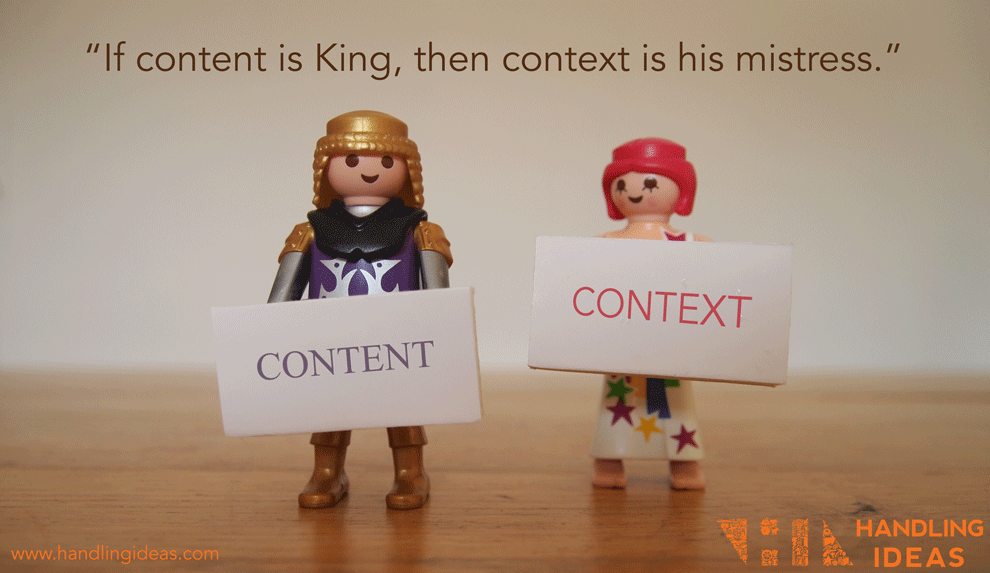Innovation happens when you bring critical & creative thinking into the same space.

Bringing critical and creative thinking into the same space reveals our justifications and shortcuts the one thing we’re always lacking when we innovate – time.
There’s so much talk of holistic solutions and co-creation within the product, service and media industry, yet such talk is hot air if we ignore the weak links within the concept development chain. I believe that it all comes down to our inability to deal with large amounts of information within the creative space and hidden motives. We’re throwing away the very thing that makes us creative, context.
The Handling Ideas method solves this by creating a single place for critical and creative thinking to come together. By visualising, mapping and prototyping we’re able to handle much larger amounts of input and see the rational for our innovation, and this is the why and how.
A right Royal Affair
In 1999, Peter Mechels, a man ahead of his time, said ‘if content is King, then context is his mistress’. Maintaining the monarch’s role appeased the content makers and yet a nod to the royal lover revealed where the real influence was growing. Forward wind fifteen years and understanding context has shown itself to be vital if storytellers, content makers, designers, communicators and marketers are to gain attention around their content and stay relevant.
It’s all around you
Critical thinking gives us context, by breaking down what’s happening in the world around us: how do audiences respond to a theme, how do travellers move through an airport, when do shoppers switch from high street to online. Irrespective of whether you’re an artist, designer, developer, commissioner, financier, communicator or marketer you explore the situations that both reinforce old needs and generate new ones. You take the trends, patterns, cultural shifts and social norms that arise from the adoption of new technologies, policies and practices and turn them into strategies. Such strategies in turn give creative thinkers a direction to generate content: the stories, concepts, projects, products, campaigns and services, that want to make an impact.
So where’s the problem?
Teams often struggle to handle the insight that is gathered around audience behaviours, attitudes, motives, goals etc. within the creative space. Documents are great containers for such data. They’re light and travel quickly and easily, but all too often, the stuff they contain, is ignored. Rather than incorporate this rich source of inspiration, it remains buried within the written summaries and conclusions. There doesn’t appear to be a natural fit within the more open and creative blank canvas of the creative thinking stage. So how can we create a single space in which critical thinking and creative thinking can come together so that the things we create are shaped by the insight we’ve gained? How can content be created as a response to context? How can we expose and manage the variety of motives for how a concept is developed? The answer? We visualise, map and prototype everything in one single space.
Horse and the cart
Let’s start moments after we’ve had an idea or received a brief. If we start with critical thinking rather than simply building on the idea, we can explore and map context. Here we can capture our assumptions e.g. how we imagine someone might interact with an existing service, say an ATM machine or an audio-visual historical guide to a museum. We can map out where they’ve come from, their goal, and their motive for that goal, their expectations, desired outcome, the way they navigate the existing service and their exit route. At any stage, we can replace our assumptions with genuine insight, modifying our map as we research and tighten the journey. We might even map in the competitors, their products and alternative services etc. The journey becomes a frame, containing both hypotheses and real data. It reveals context. We can also map in the little that we know of our new service. Even if it’s not yet formed, we can still represent us, the owner of the service, our goals, motives, stakeholder needs, desired outcomes etc. Our concept starts to form alongside the insight, exploiting various touch points between the behaviour and actions of the user and our new service; our content is forming alongside context.

Shortcut to the gold
But what makes the Handling Ideas approach so special is that when we choose one object from amongst hundreds of other objects to map, we expose the justification for each choice, thereby revealing our rationale at that point within the development. Understanding rationale is gold dust because it speeds things up by getting to the essence of the work.
It doesn’t have to be complicated
By mapping and justifying each of the elements that make up the concept, including tangible ones (user, product, output etc.) and intangible ones, (motive, conflict, goal etc.) we ensure that everyone understands what lies behind the work and can retain much more information as they co-create. If someone says “I’m going to represent the user with this small dog because it reminds me that the user is very dependent at this stage”, people will both remember that it’s there to represent the user and that the person choosing the object believes that one key aspect of that user is that they are dependent. Suddenly critical and creative thinking combines, as everyone is able to express, hold and understand a greater amount of information. It’s that simple.